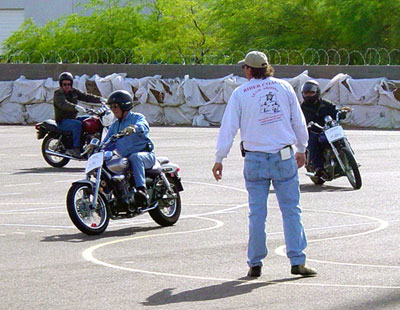Lots of people have different ideas about how to approach learning to ride a motorcycle. Some people believe in the "throw you in the deep end" philosophy, which pretty much entails hopping onto a bike and figuring things out. Others feel like the "baby steps" approach is right and take forever to graduate from riding around in parking lots to actually hitting the streets. While no single approach is going to be best for every new rider, there are a few basic things that every person who is interested in learning to ride a motorcycle should think about when they are first starting out.
Go to the International Motorcycle Show
 |
| Image courtesy of VikingBags.com |
Learn to ride a bicycle
Learn how to drive a manual transmission
Consider this my shameless plug for manual transmissions, but it is genuinely a helpful skill to have when learning to operate a motorcycle. Teaching your body the coordination necessary to smoothly manage a manual transmission in daily driving goes a long way towards giving you a head start on the kind of coordination involved in changing gears on a motorcycle. While the specific motions are different, the concepts are pretty much the same and if you can figure out how to shift a manual transmission, then you can learn how to shift gears on a motorcycle and it will make you feel that much more confident with riding. If driving a manual transmission car makes you shake uncontrollably or makes you flustered, motorcycling may not be for you.
Attend your local MSF course
 |
| Image courtesy of Wikipedia |
Some people invest thousands, sometimes tens of thousands, of dollars in gear and a motorcycle only to discover during the MSF course that they are not comfortable with motorcycling. By taking the course first, it gives you an opportunity, as a new rider, to truly understand everything that is involved in riding without sinking in a massive investment upfront. Additionally, this course prepares you with the basic skills you need to ride safely and gives you the foundation that you can use to practice until you are comfortable enough to go out onto the streets and face traffic. Best of all, many of these courses allow riders to skip the skills test portion of the licensing process in their jurisdiction.
Buy quality protective gear
Once you have taken the MSF course and are absolutely certain that motorcycling is for you, invest in some quality protective gear. At a minimum, a solid DOT-certified full-face helmet, a properly-fitted armored jacket, a pair of armored overpants, and a pair of gauntlet style leather gloves. Each of these is a key part of keeping you safe on the motorcycle and will greatly improve your enjoyment of the bike as well. If you have it in the budget, make sure you also spring for a pair of motorcycle boots, which provide greater protection and are often significantly more comfortable for riding. If it is not in the budget, this is something that you should save up for and try to add as quickly as possible.
Keep in mind that quality does not necessarily mean expensive as you can buy top quality gear that is one or two generations old for substantially less than the latest and greatest. You may not get the latest technology and styles, but you will still be able to get excellent protective qualities that the gear affords. And if your budget allows, spring for the latest stuff to take advantage of advancement in technolgy that allow the gear to be less bulky while still providing the same kind of protection.
Of course, the one thing you should never skimp on is the helmet. No matter what, buy the best full-face helmet you can possibly afford. Again, quality is not always about cost and there are a number of things to consider when buying a helmet. Different helmet manufacturers will have designs that fit different head shapes and it is important to get a helmet that fits well. Make sure to try on a variety of helmets at the local motorcycle shop to understand the differences in fit and find the one that is the best possible fit for you. Investing in a good, properly fitting helmet could very well save your life should you ever have the misfortune of being involved in an accident. And most important of all, never buy a used helmet. You simply cannot know what has happened to that helmet before you got your hands on it so buying new is the best way to ensure your safety.
On your way...
Of course, there is so much more to learning to ride, but taking these steps should at least get you started down the path towards making motorcycling a part of your life. It is important to recognize that motorcycling is not for everyone. Those of us who ride need to take the right steps to ensure that motorcycling is safe and enjoyable. If you do decide to start down the path of learning to ride, make the most of every opportunity to educate yourself on safety and technique so that you can get the most out of the experience. As you become a better rider, the enjoyment factor continues to grow and it becomes a life-long skill that will bring countless years of enjoyment. I know I personally will continue to ride for as long as my body allows, an ear-to-ear grin plastered on my face beneath my helmet..




No comments :
Post a Comment